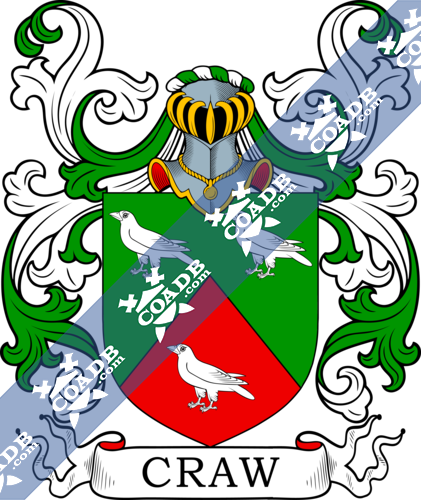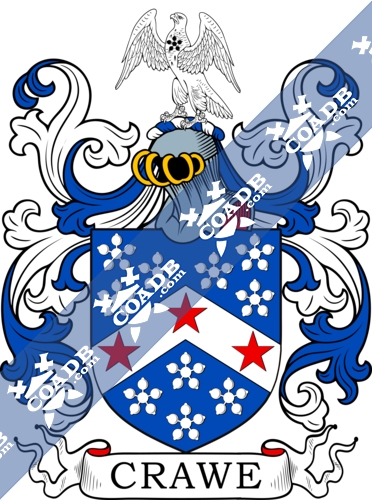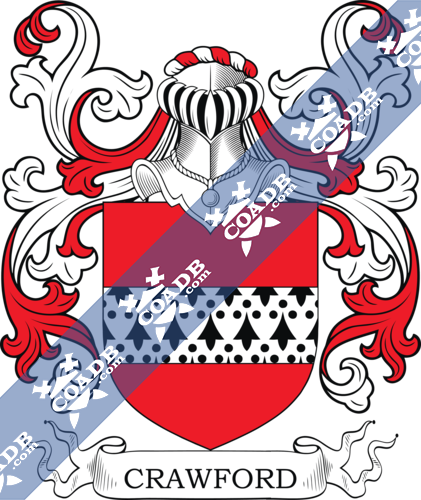Craw Family Crest, Coat of Arms and Name History

Craw Coat of Arms Gallery
Don’t know which Coat of Arms is yours?
We can do a genealogical research. Find out the exact history of your family!
Learn MoreCraw Origin:
England, Ireland
Origins of Craw:
This surname, with various spellings such as Crow, has two different possible sources, one English and the other Gaelic Irish. In the first example, the source is from the Middle English “crowe” (Olde English “crawa”), which means “crow,” and formerly provided as a nickname to a person considered to bear an imagined similarity to the bird, maybe a person with especially dark hair. The surname from this origin first develops on the register in the late part of the 12th Century. Other early documentations contain a Nicholas Crowe, in the 1187 Pipe Rolls of Norfolk, and William Croe, in the Hundred Rolls of Suffolk, dated 1273. One Thomas Crow, listed in Registers of the Jurisdiction of Dunblane, shows to be the first Scottish name carrier. In Ireland, the surname Crow(e) is used as an Anglicized form of the Old Gaelic surname “Mac Enchroe” from an initial “Mac Conchradha,” “son of Conchradha,” a particular name including the component “con,” which means follower. The Slogan “Skeagh mac en chroe” is joined to the Coat of Arms for the Crow(e) family of Division Clare. Mitford Crow, Colonel and British consular agent, became administrator of Barbados in 1707
Variations:
More common variations are: Cgraw, Caraw, Crraw, Crauw, Coraw, Craow, Creaw, Curraw, Carraw, Cawraw.
England:
The surname Craw first appeared in Lancashire at Cranshaw (Cronkshaw) in the church of Rochdale or Bury. One of the first registers of the name was William de Crounkeshawe who was noted there in 1412. Cranshaws Castle or Cranshaws Tower is a 15th-century pele near the hamlet of Cranshaws in Berwickshire, Scotland. The palace considered being the motivation for “Ravenswood Palace,” home of Edgar, the hero of Sir Walter Scott’s play the Bride of Lammermoor.
The very first recording spelling of the family was shown to be that of Ailwin Crawe, dated about 1180, in the “Pipe Rolls of Warwickshire.” It was during the time of King Henry II who was known to be the “The Builder of Churches”, dated 1154-1189. The origin of surnames during this period became a necessity with the introduction of personal taxation. It came to be known as Poll Tax in England. Surnames all over the country began to develop, with unique and shocking spelling varietions of the original one.
Ireland:
Many of the people with surname Craw had moved to Ireland during the 17th century.
United States of America:
Individuals with the surname Craw landed in the United States in two different centuries respectively in the 17th and 19th. Some of the people with the name Craw who arrived in the United States in the 17th century included Samll Craw, who came to Virginia in 1664.
The following century saw much more Craw surnames come. Some of the people with the surname Craw who arrived in the United States in the 18th century included Daniel Craw, who landed in Florida in 1765.
Here is the population distribution of the last name Craw: United States 1,418; Philippines 387; New Zealand 381; England 253; Scotland 203; Australia 201; Canada 82; Brazil 79; South Africa 73; Spain 3.
Notable People:
Demas Thurlow “Nick” Craw (April 1900 – November 1942) was an American Army Air Forces officer and a winner of the United States military’s highest decoration—the Medal of Honor—for his efforts in World War II.
Garvie Craw (January 1948 – July 2007) was an American football player. He played college football at the University of Michigan from the year 1967 to the year 1969.
Pavel Kravar (near the year 1391-July 1433), or Paul Crawar, Paul Craw, was a Hussite emissary from Bohemia who was burned at the stake for heresy at St Andrews in Scotland in July in the year 1433. He was the first of a series of religious reformers who were sainted in the town throughout the development of the subsequent Protestant Reformation. (The others being: Patrick Hamilton in 1528, Henry Forest in 1533, George Wishart in 1546, and Walter Myln in 1558).
Charles D. Craw (c.1941-present), is a Naval Chief Petty Officer out of the U.S.S. Sea Robin (SS 407).
Blazons & Genealogy Notes
1) (Auchencraw, co. Berwick). Per chev. vert and gu. three crows ar.
2) (East Reston, co. Haddington). Motto: Cui debeo fidus. Per chev. embattled vert and gu. three crows ar. Crest—An eagle guard. ppr. beaked and armed gu.
3) (Netherbyre, Scotland). Motto—God is my safety. The same Arms, within a bordure counterchanged of the second and first. Crest—A crow ppr.
4) Az. on a chev. betw. ten cinquefoils ar. three mullets gu. Crest—A hawk with wings expanded ar. charged on the breast with a cinquefoil sa.










